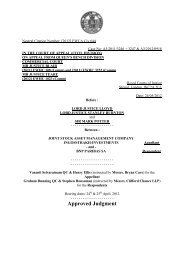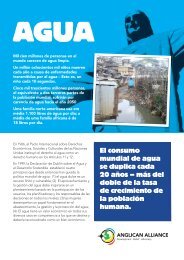Megaprojects - KPMG
Megaprojects - KPMG
Megaprojects - KPMG
Create successful ePaper yourself
Turn your PDF publications into a flip-book with our unique Google optimized e-Paper software.
We very quickly came to realize that there was no point in<br />
building an inland port if we couldn’t offer reliable, cost effective<br />
and efficient linkages between the intermodal terminal and the<br />
sea port at Botany.<br />
Robin Renwick, First Assistant Secretary at the Moorebank Project Office<br />
Managing a multi-stakeholder<br />
environment<br />
The project team also needed to coordinate<br />
across multiple levels of government to<br />
ensure all stakeholders were not only<br />
involved, but also actively participating in<br />
the project. “The Moorebank Project Office<br />
is essentially a partnership between three<br />
Commonwealth government departments,<br />
but the port and surrounding roads are<br />
owned by the state, and the land around<br />
the terminal is administered by the local<br />
council,” added Mr Renwick. “Layer over<br />
top all of the consultations that must be<br />
conducted with other government functions<br />
such as customs, environment and planning,<br />
and you are looking at a rather complex set<br />
of public sector stakeholders to coordinate<br />
and manage.”<br />
Given that the project is largely a<br />
commercial endeavor (albeit with significant<br />
social, political and economic benefits<br />
attached), the needs of the private sector<br />
are also being carefully considered. “The<br />
government does not want to design or build<br />
this terminal themselves and – wherever<br />
possible – we want the private sector to<br />
finance it,” noted Mr. Renwick. “So a large<br />
part of what we are trying to do is essentially<br />
‘de-risk’ the areas that the government can<br />
impact.”<br />
Tips for megaproject success<br />
Based on his experience to date, Mr.<br />
Renwick has three key areas of advice<br />
for other megaproject owners around the<br />
world. The first is to ensure you have a clear<br />
understanding of the interdependencies of<br />
the project and what those entail. “This is<br />
essentially all about bringing together a really<br />
good team that includes key stakeholders as<br />
well as expert advisors that can help develop<br />
a robust feasibility study and business case<br />
at the outset,” he suggested. “Particularly in<br />
government-led projects, the need to provide<br />
strong evidence-based policy advice is critical<br />
to capturing broad stakeholder support.”<br />
Creating and executing a robust<br />
communications plan is also key to achieving<br />
broad-based support from stakeholders and<br />
the community. “I find that a lot of projects<br />
that ultimately fail to either get off the<br />
ground or achieve their projected benefits are<br />
handicapped by insufficient or inappropriate<br />
communications,” he noted. “We engaged a<br />
communications research team and advisor<br />
to help feed in to the project on an ongoing<br />
basis and help us ensure that there weren’t<br />
any surprises out there.”<br />
Thirdly, Mr. Renwick notes the importance<br />
of strong leadership. “Complex megaprojects<br />
of this size and scope absolutely require<br />
someone who can be a strong sponsor<br />
and carry the project forward; someone<br />
that can bring together minds from across<br />
the public and private sector to focus on<br />
working together to achieve the stated<br />
outcomes,” he added.<br />
Ultimately, Mr. Renwick notes that no<br />
two projects are the same and that project<br />
owners and their advisors must therefore<br />
be cognizant of all of the unique factors<br />
that impact a project. “Anyone can throw<br />
money at a project and get the thing built,<br />
but there is a huge difference between<br />
building an asset and actually making it<br />
work in a way that delivers results for<br />
the stakeholders and the community,” he<br />
summarized. “Inevitably, that tends to expand<br />
the project into a much broader range of<br />
issues and interdependencies than most<br />
project owners would expect.”<br />
<strong>Megaprojects</strong> | INSIGHT | 47


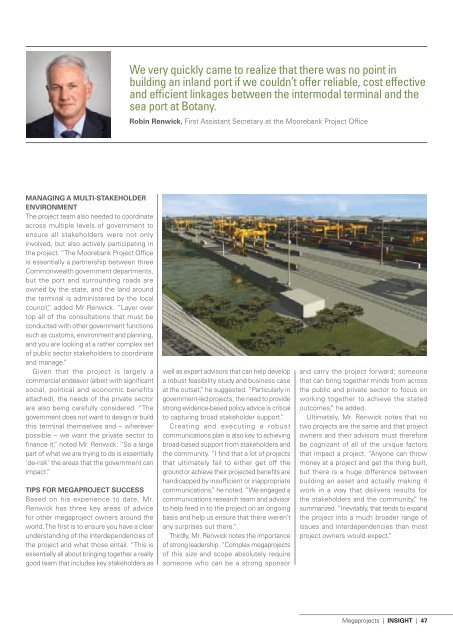

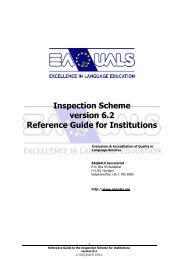
![[2012] UKUT 399 (TCC)](https://img.yumpu.com/51352289/1/184x260/2012-ukut-399-tcc.jpg?quality=85)



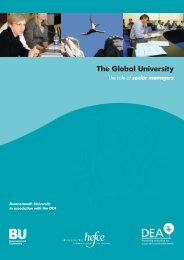

![Neutral Citation Number: [2009] EWHC 3198 (Ch) Case No: CH ...](https://img.yumpu.com/50120201/1/184x260/neutral-citation-number-2009-ewhc-3198-ch-case-no-ch-.jpg?quality=85)
